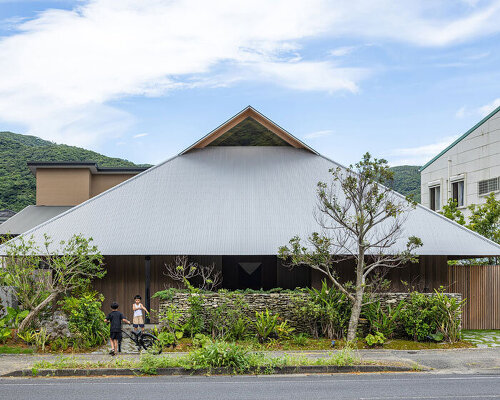Sakai Architects designs self-sufficient residence on AMAMI ISLAND
Located in the center of Amami Island, Japan, Off-Grid House by Sakai Architects is a self-sufficient family residence designed to operate entirely independent of the national power grid. The project explores architecture as a model for circular living in response to environmental change and regional depopulation, integrating spatial, climatic, and social systems within a subtropical island context. The design originates from a research process into local vernacular building methods and contemporary strategies for self-reliance. Following feasibility studies on renewable energy options, including solar, wind, hydro, and geothermal, solar generation was identified as the most viable energy source despite limited regional irradiation. The residence functions autonomously through a combination of photovoltaic power, composting systems, and wood fuel recycled from construction offcuts.
Rooted in the island’s buntō (multi-volume) layout tradition, the plan consists of five interconnected structures, each dedicated to a specific function, such as bathing, sleeping, and storage. These volumes are arranged geometrically to create intermediary outdoor and semi-enclosed zones that serve as shared living and gathering areas. The resulting spatial configuration allows continuous airflow and natural ventilation while establishing fluid transitions between interior and exterior environments. The roof design draws from Amami’s vernacular irimoya (hip-and-gable) and corrugated-metal forms, reinterpreted with layered insulation and ventilation cavities for climatic adaptability. Deep eaves mitigate direct solar exposure and tropical rainfall, while the raised structure references takakura granaries, enabling cross-ventilation and resilience to humidity.
all images by Toshihisa Ishii
OFF-GRID HOME models ecological autonomy and collective living
Locally sourced and recycled materials are employed throughout. A wood-fired sauna utilizes offcuts from the building process as fuel, reinforcing the project’s closed-loop approach to resources. Organic waste is composted and reused in the adjoining vegetable garden, forming a self-sustaining ecosystem in which household production and consumption coexist. Studio Sakai Architects draws from Amami Island’s cultural identity, often described as the ‘Island of Ties,’ to inform the project’s social dimension. The flexible spatial organization accommodates both daily family life and larger community gatherings, reflecting the island’s cooperative traditions of yui (collective effort).
Through its integration of traditional planning logic, material efficiency, and ecological autonomy, Off-Grid House demonstrates an alternative model for domestic architecture in subtropical climates. The project situates habitation within a broader network of environmental and cultural continuity, proposing a resilient framework for living beyond conventional infrastructural systems.
engawa space
dining space
guest entrance
tatami space
corridor and desk
living space
loft space
sauna
night front facade
project info:
name: Amami House
architects: Sakai Architects | @sakaiarchitects
lead architect: Kazunori Sakai
location: Amami Island, Japan
photographer: Toshihisa Ishii
designboom has received this project from our DIY submissions feature, where we welcome our readers to submit their own work for publication. see more project submissions from our readers here.
edited by: christina vergopoulou | designboom
The post five interconnected timber volumes shape off-grid house on japanese island appeared first on designboom | architecture & design magazine.

